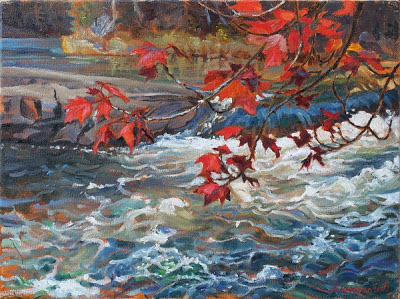Gannet on the Beach (oil on canvas 5 x 7 in.) SOLD!
24 August finds me sketching one of three Gannets that Fred found dead on the beach north west of where we are camped. I have photographed it for an oil painting, but the evening light will not last long enough to even get the painting started, so I will replace this sketch with the painting when it is complete (completed on 29 August and replacing the sketch, which remains in my journal).
The death of three Gannets, spaced out along 3.5 kilometres of sandy beach is a mystery to us. Their feathers are a gleaming white, highly reflective as if they were clothed with light. The stripes on their black feet are pale blue, as are their beaks, and the longer feathers on their heads are golden-yellow. The eyes are positioned so that they can see directly below them - the better to see fish while flying.
Gannets dive from 30 metres above the water, reaching speeds of up to 100 kilometres per hour, penetrating the ocean to greater depths than other diving birds can reach. They don't have external nostrils, and they also have special air sacs under their skin to cushion the impact.
Fred saw one adult Gannet diving for fish as he walked, finding its dead relatives on the beach.
The death of three Gannets, spaced out along 3.5 kilometres of sandy beach is a mystery to us. Their feathers are a gleaming white, highly reflective as if they were clothed with light. The stripes on their black feet are pale blue, as are their beaks, and the longer feathers on their heads are golden-yellow. The eyes are positioned so that they can see directly below them - the better to see fish while flying.
Gannets dive from 30 metres above the water, reaching speeds of up to 100 kilometres per hour, penetrating the ocean to greater depths than other diving birds can reach. They don't have external nostrils, and they also have special air sacs under their skin to cushion the impact.
Fred saw one adult Gannet diving for fish as he walked, finding its dead relatives on the beach.




I was so anxious to see gannets after seeing their cousins, the blue-footed, red-footed and Nazca boobies on the Galapagos Islands. The boobies, and the flightless cormorants, weren't at all afraid of humans, because the wildlife in the Galapagos does not see man as a threat, even though man has decimated the tortoise population and killed many boobies. But they remain quite pleased to be photographed, and I loved them. So I went to the Gaspe Peninsula to see the gannets doing the fun boobie things like sky-pointing and doing mating dances. Didn't get close to them, and was unable to walk from one side of Bonaventure Island to the other to see the nesting colony. They, like the boobies and cormorants, do elaborate things with their necks and their beaks when they are courting. It would have been wonderful to see.
ReplyDeleteSad, perhaps, but a good thing for you to have one from which to paint.
If I could send you this little picture of two gannets I snarfled from a Via Rail publication, it might help. Let me see, perhaps I can e-mail it.
This one was evidently killed, despite the lack of external trauma, by a rifle shot to the neck at the base of the skull. The other one I brought back had its belly opened by scavengers (Gulls, Ravens, etc) and may have had more damage to the lower spine and pelvis than scavengers could have been expected to inflict. Both have been prepared as specimens for the New Brunswick Museum, which doesn't (fide Don McAlpine) have many Gannets from Northumberland Strait.
ReplyDelete